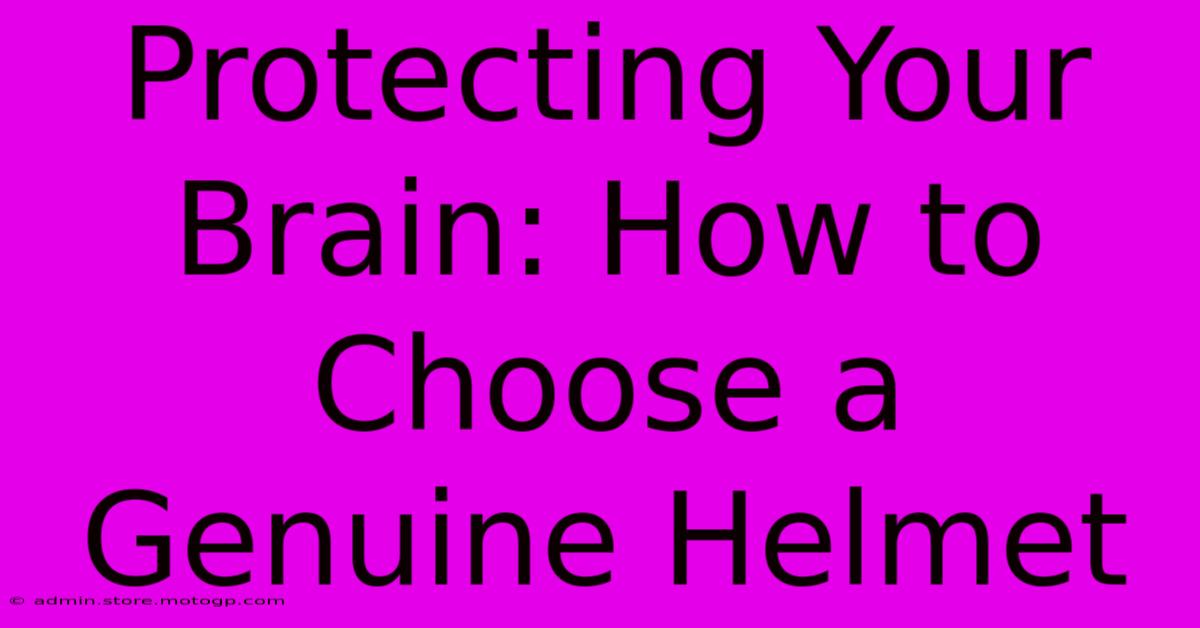Protecting Your Brain: How To Choose A Genuine Helmet

Table of Contents
Protecting Your Brain: How to Choose a Genuine Helmet
Choosing the right helmet can be a matter of life or death. Whether you're a cyclist, motorcyclist, skateboarder, or simply someone who values head protection, understanding how to identify and select a genuine, high-quality helmet is crucial. A counterfeit helmet might look the part, but it offers significantly less protection, putting you at serious risk of injury. This comprehensive guide will walk you through the essential steps to ensure you're investing in a helmet that genuinely protects your brain.
Understanding Helmet Safety Standards
Before diving into specific features, it's vital to understand the importance of safety standards. Reputable helmets meet stringent testing protocols designed to assess their ability to withstand impacts. These standards vary depending on the type of helmet and your location, but some key certifications to look for include:
- DOT (Department of Transportation): A common standard in the United States for motorcycle helmets.
- ECE 22.05 (Economic Commission for Europe): A widely recognized European standard for motorcycle helmets. Often seen as a more stringent standard than DOT.
- SNELL: A voluntary safety standard known for its rigorous testing procedures. SNELL-certified helmets typically offer higher levels of protection.
- CPSC (Consumer Product Safety Commission): Covers bicycle helmets and other sports helmets in the United States.
Look for the certification sticker! A genuine helmet will clearly display the relevant safety certification label. If the label is missing or looks suspicious, be wary.
Key Features of a Genuine Helmet
Beyond safety certifications, several features distinguish a genuine helmet from a counterfeit:
1. Construction and Materials:
- Shell: A genuine helmet will have a robust outer shell, typically made from ABS plastic or advanced composites like carbon fiber. Feel the shell; it should be strong and not easily dented. Counterfeit helmets often have flimsy shells.
- Inner Liner: The inner liner is crucial for impact absorption. Look for high-density EPS (expanded polystyrene) foam. It should be firmly attached to the shell and not easily compressed.
- Straps and Buckles: Genuine helmets use high-quality straps and buckles that are securely fastened and easy to adjust. Check for sturdy stitching and smooth operation.
2. Fit and Comfort:
- Proper Fit: A helmet that fits poorly will offer inadequate protection. It should sit snugly but comfortably, covering your forehead and temples. The chin strap should be secure without being too tight.
- Ventilation: Proper ventilation is essential for comfort, especially during prolonged use. Genuine helmets usually have strategically placed vents to improve airflow.
3. Manufacturer Information and Packaging:
- Authentic Branding: A genuine helmet will have clear and legible branding from the manufacturer. Check the manufacturer’s website to verify authenticity.
- Detailed Packaging: Counterfeit helmets often come in poorly made or unmarked packaging. Genuine helmets typically come in well-designed boxes with clear instructions and information.
- Retailer Reputation: Purchase your helmet from a reputable retailer, either online or in person. This reduces the risk of buying a counterfeit product.
Identifying Counterfeit Helmets: Red Flags
Several red flags can indicate a counterfeit helmet:
- Unusually low price: If a helmet is significantly cheaper than comparable models, it's likely a counterfeit.
- Poor craftsmanship: Look for loose stitching, uneven paint, or other signs of shoddy construction.
- Missing or unclear safety certification: The absence of a clear safety certification label is a major red flag.
- Suspicious packaging or branding: Poorly printed packaging or unclear branding can indicate a counterfeit.
Conclusion: Protecting Your Most Valuable Asset
Your brain is your most valuable asset. Investing in a genuine, high-quality helmet is an investment in your safety and well-being. By understanding safety standards, examining helmet features, and being aware of red flags, you can make an informed decision and choose a helmet that provides the protection you deserve. Remember, a cheap helmet is an expensive mistake. Prioritize safety and choose a genuine helmet from a reputable source.

Thank you for visiting our website wich cover about Protecting Your Brain: How To Choose A Genuine Helmet. We hope the information provided has been useful to you. Feel free to contact us if you have any questions or need further assistance. See you next time and dont miss to bookmark.
Featured Posts
-
Moto Gp Sprint Race A Global Phenomenon
Feb 19, 2025
-
Tnt Sports Moto Gp The Road To Championship Glory
Feb 19, 2025
-
Moto Gp Qualifying The Ultimate Test Of Speed
Feb 19, 2025
-
Us Grand Prix Sprint Time The Heart Of Racing
Feb 19, 2025
-
Protect Your Head Invest In A Moto Gp Helmet Today
Feb 19, 2025
